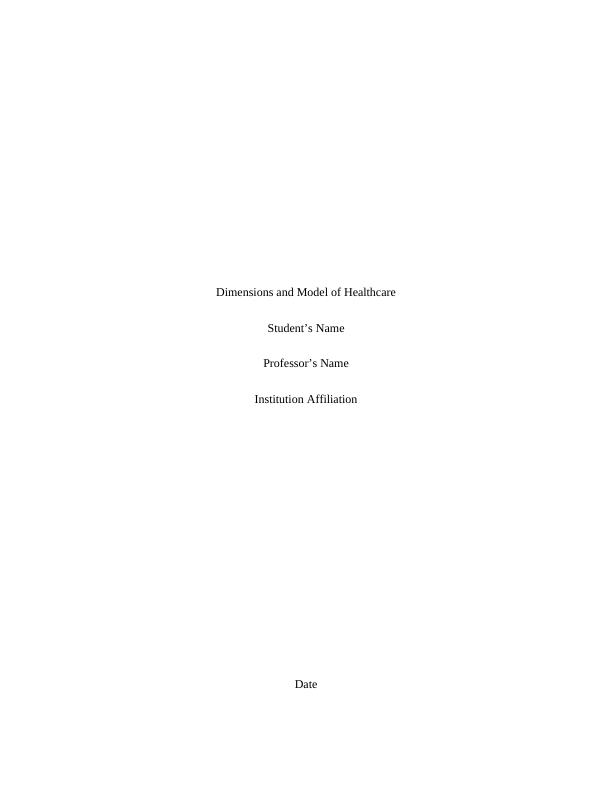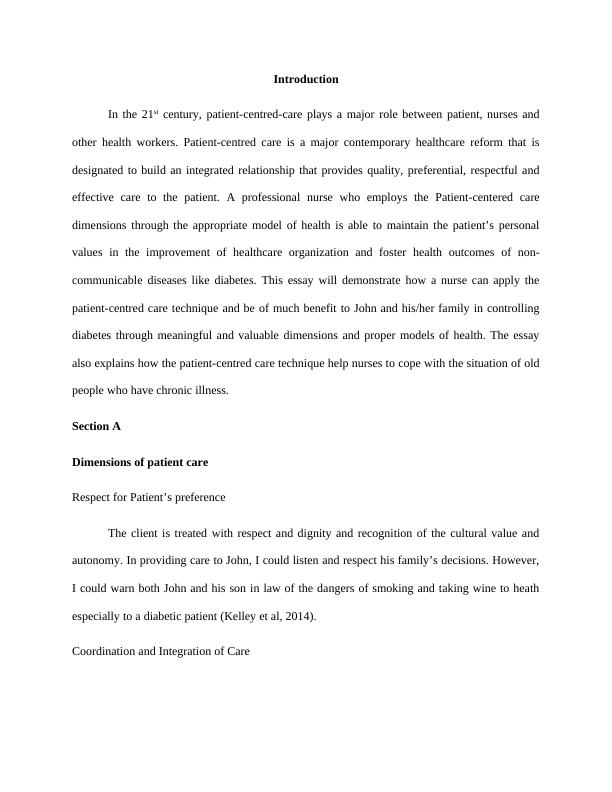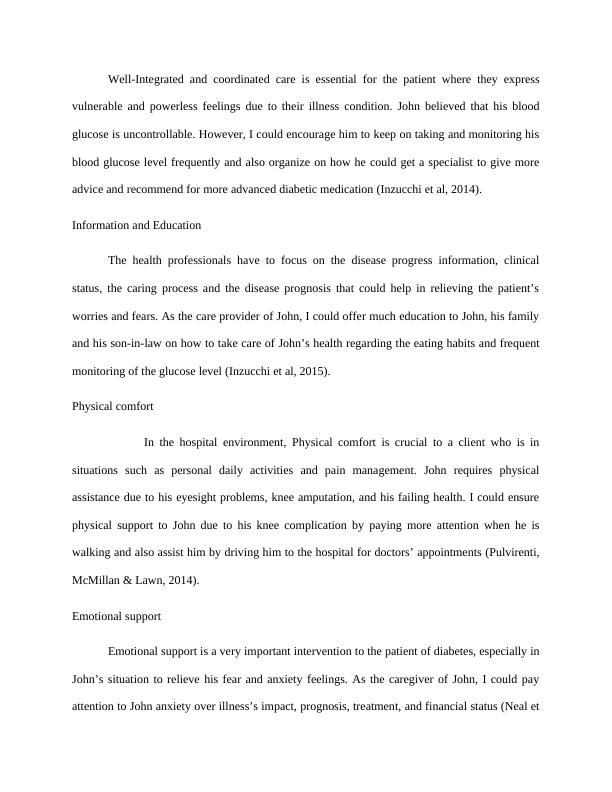Dimensions and Model of Healthcare
Added on 2021-12-07
9 Pages2058 Words207 Views
Dimensions and Model of Healthcare
Student’s Name
Professor’s Name
Institution Affiliation
Date
Student’s Name
Professor’s Name
Institution Affiliation
Date

Introduction
In the 21st century, patient-centred-care plays a major role between patient, nurses and
other health workers. Patient-centred care is a major contemporary healthcare reform that is
designated to build an integrated relationship that provides quality, preferential, respectful and
effective care to the patient. A professional nurse who employs the Patient-centered care
dimensions through the appropriate model of health is able to maintain the patient’s personal
values in the improvement of healthcare organization and foster health outcomes of non-
communicable diseases like diabetes. This essay will demonstrate how a nurse can apply the
patient-centred care technique and be of much benefit to John and his/her family in controlling
diabetes through meaningful and valuable dimensions and proper models of health. The essay
also explains how the patient-centred care technique help nurses to cope with the situation of old
people who have chronic illness.
Section A
Dimensions of patient care
Respect for Patient’s preference
The client is treated with respect and dignity and recognition of the cultural value and
autonomy. In providing care to John, I could listen and respect his family’s decisions. However,
I could warn both John and his son in law of the dangers of smoking and taking wine to heath
especially to a diabetic patient (Kelley et al, 2014).
Coordination and Integration of Care
In the 21st century, patient-centred-care plays a major role between patient, nurses and
other health workers. Patient-centred care is a major contemporary healthcare reform that is
designated to build an integrated relationship that provides quality, preferential, respectful and
effective care to the patient. A professional nurse who employs the Patient-centered care
dimensions through the appropriate model of health is able to maintain the patient’s personal
values in the improvement of healthcare organization and foster health outcomes of non-
communicable diseases like diabetes. This essay will demonstrate how a nurse can apply the
patient-centred care technique and be of much benefit to John and his/her family in controlling
diabetes through meaningful and valuable dimensions and proper models of health. The essay
also explains how the patient-centred care technique help nurses to cope with the situation of old
people who have chronic illness.
Section A
Dimensions of patient care
Respect for Patient’s preference
The client is treated with respect and dignity and recognition of the cultural value and
autonomy. In providing care to John, I could listen and respect his family’s decisions. However,
I could warn both John and his son in law of the dangers of smoking and taking wine to heath
especially to a diabetic patient (Kelley et al, 2014).
Coordination and Integration of Care

Well-Integrated and coordinated care is essential for the patient where they express
vulnerable and powerless feelings due to their illness condition. John believed that his blood
glucose is uncontrollable. However, I could encourage him to keep on taking and monitoring his
blood glucose level frequently and also organize on how he could get a specialist to give more
advice and recommend for more advanced diabetic medication (Inzucchi et al, 2014).
Information and Education
The health professionals have to focus on the disease progress information, clinical
status, the caring process and the disease prognosis that could help in relieving the patient’s
worries and fears. As the care provider of John, I could offer much education to John, his family
and his son-in-law on how to take care of John’s health regarding the eating habits and frequent
monitoring of the glucose level (Inzucchi et al, 2015).
Physical comfort
In the hospital environment, Physical comfort is crucial to a client who is in
situations such as personal daily activities and pain management. John requires physical
assistance due to his eyesight problems, knee amputation, and his failing health. I could ensure
physical support to John due to his knee complication by paying more attention when he is
walking and also assist him by driving him to the hospital for doctors’ appointments (Pulvirenti,
McMillan & Lawn, 2014).
Emotional support
Emotional support is a very important intervention to the patient of diabetes, especially in
John’s situation to relieve his fear and anxiety feelings. As the caregiver of John, I could pay
attention to John anxiety over illness’s impact, prognosis, treatment, and financial status (Neal et
vulnerable and powerless feelings due to their illness condition. John believed that his blood
glucose is uncontrollable. However, I could encourage him to keep on taking and monitoring his
blood glucose level frequently and also organize on how he could get a specialist to give more
advice and recommend for more advanced diabetic medication (Inzucchi et al, 2014).
Information and Education
The health professionals have to focus on the disease progress information, clinical
status, the caring process and the disease prognosis that could help in relieving the patient’s
worries and fears. As the care provider of John, I could offer much education to John, his family
and his son-in-law on how to take care of John’s health regarding the eating habits and frequent
monitoring of the glucose level (Inzucchi et al, 2015).
Physical comfort
In the hospital environment, Physical comfort is crucial to a client who is in
situations such as personal daily activities and pain management. John requires physical
assistance due to his eyesight problems, knee amputation, and his failing health. I could ensure
physical support to John due to his knee complication by paying more attention when he is
walking and also assist him by driving him to the hospital for doctors’ appointments (Pulvirenti,
McMillan & Lawn, 2014).
Emotional support
Emotional support is a very important intervention to the patient of diabetes, especially in
John’s situation to relieve his fear and anxiety feelings. As the caregiver of John, I could pay
attention to John anxiety over illness’s impact, prognosis, treatment, and financial status (Neal et

End of preview
Want to access all the pages? Upload your documents or become a member.
Related Documents
Dimensions and Model of Healthcare PDFlg...
|9
|2058
|85
Patient-Centred Care and Models of Health for Type 2 Diabeteslg...
|10
|2371
|241
NUR1202: Legal issues and conceptslg...
|10
|2179
|73
Professional Identity in Nursing : Essaylg...
|7
|1673
|115
Dimensions of Care .lg...
|8
|1898
|278
Diabetic Patient: Managing Type 2 Diabetes and Social Isolationlg...
|8
|2359
|68
